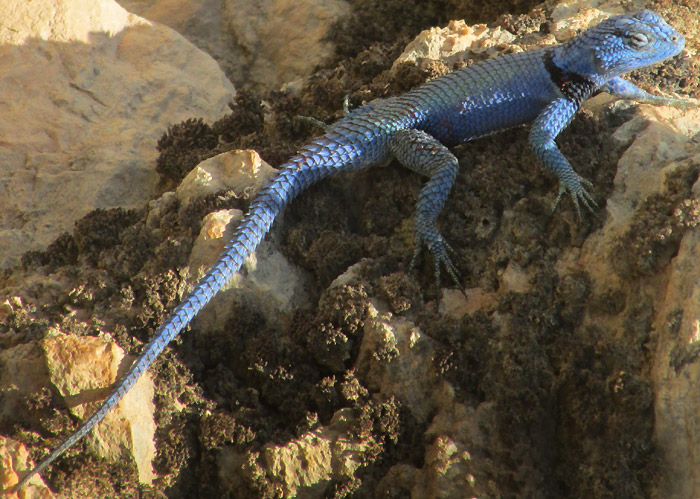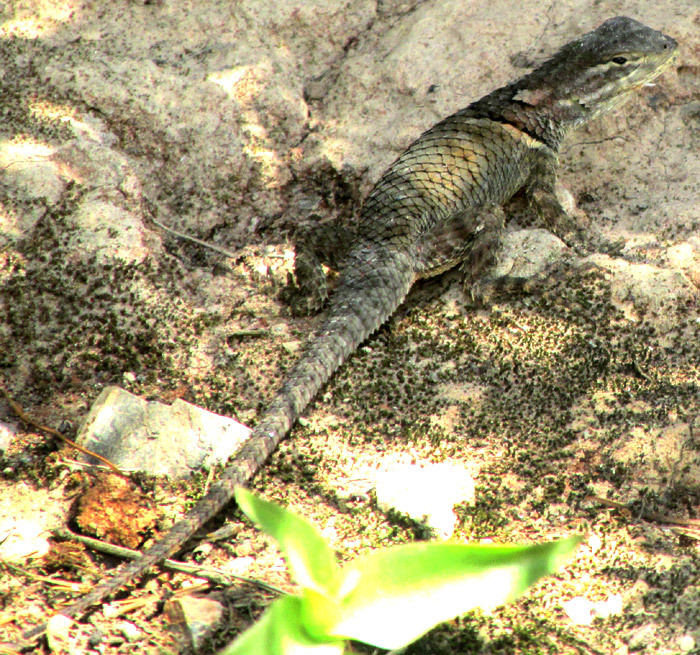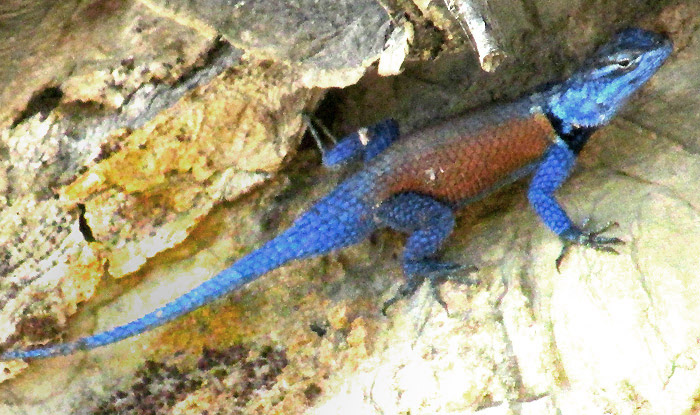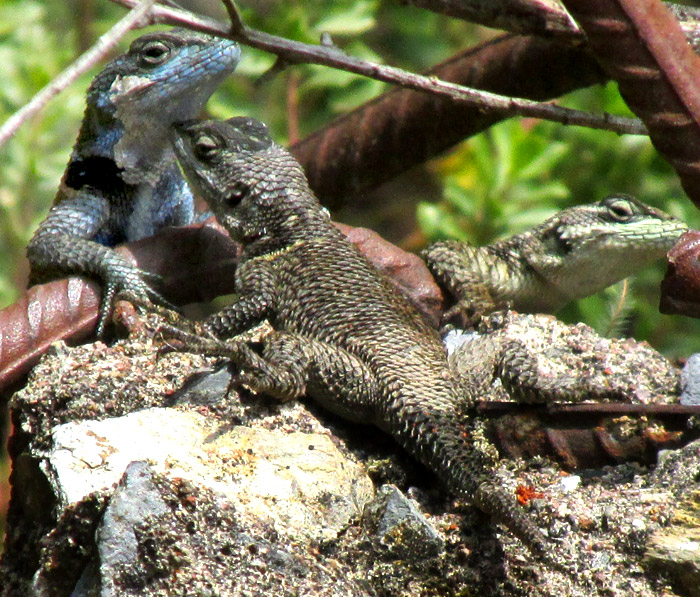Excerpts from Jim Conrad's
Naturalist Newsletter
Entry from field notes dated September 1, 2023, taken in Los Mármoles National Park in the Eastern Sierra Madre mountains, Hidalgo state, MÉXICO; forested ridge near fork in road leading to Puerto de Piedra, on road between town of Trancas {on maps designated "Morelos (Trancas)"} and Nicolás Flores; oak/pine forest on limestone bedrock; elevation ~2,300m (~7,550ft); ~N20.80°, ~W99.24°
SOUTHERN BLUE MINOR LIZARD

Along the road, the above astonishingly blue lizard was one of several of the same species in the neighborhood patrolling near-vertical, south-facing walls cut into limestone. Other individuals bore patches of blue, but none was as completely blue as this one. Maybe 20 meters away the one shown below was noticed:

About a kilometer up the road, the following was seen:

Later I'd see that along this road, the above form was most commonly seen
Spiny-lizard species, genus Sceloporus, often are hard to identify, largely because the state of their taxonomic understanding is in flux, within species there can be great variations in color and markings, and many identified pictures on the Internet often turn out to be misidentified. The above lizards have been identified first by doing image searches on Sceloporus lizards occurring here in upland central Mexico, then studying the most recent literature to see which of the look-alike species can be found at our highland central Mexican location.
It came down to three very similar species which experts say exist in Hidalgo state: Sceloporus mucronatus, Sceloporus torquatus, and Sceloporus minor. The minor species is famed for the all-blue color of some of its males. However, some pictures on the Internet show all-blue individuals in the other two species as well. Above, the mostly gray individual, presumably a female, displays a golden hue along her back. Frequently pictures portray females of S. torquatus with similar golden hues, but S. minor earlier was considered a subspecies of S. torquatus, so these could be older identifications.
Whatever the case, after plenty of literature-reading and picture-comparing, I'm most confident that our Hidalgo roadcut lizards are SCELOPORUS MINOR, often known as Minor Lizards. Our pictured individuals are of the subspecies IMMUCRONATUS, known by lizard enthusiasts as Southern Blue Minor Lizards.
Males of this species display considerable variation in color. On a web page in Spanish with no author mentioned, I read that here in northwestern Hidalgo state Sceloporus minor exhibits three discrete color morphs -- blue, yellow and red.
In the old days, lizard fanciers called all of this area's spiny lizards with black collars and varying amounts of blueness Sceloporus jarrovii. But then subspecies of that taxon were recognized, and eventually most of those subspecies were raised to species level. Now subspecies have been recognized of those new species, and; our Sceloporus minor embraces four recognized subspecies. Now the comfortable old Sceloporus jarrovii is reduced to occupying small parts of Arizona and New Mexico, and northern and northwestern Mexican states well away from here, and here in the central highlands we have the pleasure of dealing with a lot of taxa with overlapping, hard-to-pin-down features.
Entry dated April 19, 2024, from notes taken about 1.5km northeast of Puerto de los Velazquez, Municipality of Pinal de Amoles; N21.138°, W99.665°, elevation ~2780 meters (~9120 feet); oak/pine forest on limestone bedrock; in the Eastern Sierra Madre Mountains of east-central Querétaro state, MÉXICO
LIZARD RENDEZVOUS

A trail up a steep slope used to have two concrete fenceposts holding a gate opening into an area fenced in with barbed wire. Now everything had gone wild again and the barbed wire lay rusting and mostly buried beneath leaves, but the concrete posts remained. As I approached, a blue-bellied lizard jumped from atop a post, paused on rocks below the post, and glared at me. He didn't seem to want to leave. In fact, within seconds he scrambled back up the fence, peeped over the edge at me, and by the time my camera was ready, he was entertaining visitors, shown above.
Keeping in mind the confusion about the naming of Sceloporus lizards looking like the above, in the 2023 work by Mauricio Tepos-Ramírez and others entitled "Annotated checklist of amphibians and reptiles from Querétaro, Mexico, including new records, and comments on controversial species," seeing that Sceloporus minor is listed as a fairly commonly occurring species in Querétaro state, we'll stick with that name here.